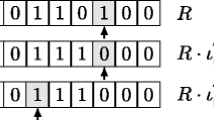Abstract
Automata theory is one of the branches of mathematical cybernetics, that studies information transducers that arise in many applied problems. The major objective of automata theory is to develop methods by which one can describe and analyze the dynamic behavior of discrete systems. Depending on study tasks, automata are considered, for which the set of states and the set of output signals are equipped with additional mathematical structures preserved by the transition and output functions of automata. In this paper, we investigate automata over graphs and call them graphic automata. For graphs \(G_{1},G_{2}\) a universal graphic automaton \(\text{Atm}(G_{1},G_{2})\) is the universally attracted object in the category of graphic automata, for which the set of states is equipped with the structure of the graph \(G_{1}\) and the set of output signals is equipped with the structure of the graph \(G_{2}\). The input signal semigroup of the universal graphic automaton is \(S(G_{1},G_{2})=\text{End}\ G_{1}\times\text{Hom}(G_{1},G_{2})\). It may be considered as a derived algebraic system of the mathematical object \(\text{Atm}(G_{1},G_{2})\). It is common knowledge that properties of the semigroup are closely interconnected with properties of the algebraic structure of the automaton. This suggests that universal graphic automata may be researched using their input signal semigroups. In this article, we investigate the concrete characterization problem of graphic automata over reflexive graphs. The main result of our study states necessary and sufficient conditions for an automaton to be a universal graphic automaton over reflexive graphs.
Similar content being viewed by others
REFERENCES
B. I. Plotkin, Groups of Automorphisms of Algebraic Systems (Nauka, Moscow, 1966) [in Russian].
A. G. Pinus, ‘‘Elementary equivalence of derived structures of free semigroups, unars, and groups,’’ Algebra Logic 43, 408–417 (2004).
A. G. Pinus, ‘‘Elementary equivalence of derived structures of free lattices,’’ Izv. Vyssh. Uchebn. Zaved. Mat., No. 5, 44–47 (2002).
Yu. M. Vazhenin, ‘‘Elementary properties of semigroups of transformations of ordered sets,’’ Algebra Logika 9, 281–301 (1970).
Yu. M. Vazhenin, ‘‘The elementary definability and elementary characterizability of classes of reflexive graphs,’’ Izv. Vyssh. Uchebn. Zaved., Ser. Mat., No. 7, 3–11 (1972).
L. M. Gluskin, ‘‘Semigroups and endomorphism rings of linear spaces,’’ Izv. Akad. Nauk SSSR, Ser. Mat. 25, 809–814 (1961).
L. M. Gluskin, ‘‘Semigroups of isotone transformations,’’ Usp. Mat. Nauk 16 (5), 157–162 (1961).
A. A. Tuganbaev, V. T. Markov, L. A. Skornyakov, and A. V. Mikhalev, ‘‘Endomorphism rings of modules, and lattices of submodules,’’ J. Sov. Math. 5, 786–802 (1976).
S. M. Ulam, A Collection of Mathematical Problems (Interscience, New York, 1960).
B. I. Plotkin, L. Ja. Greenglaz, and A. A. Gvaramija, Elements of Algebraic Theory of Automata (Vyssh. Shkola, Moscow, 1994) [in Russian].
Program of the International Conference on Algebra, Analysis and Geometry 2021, Sect. Mathematical Logic, Universal and Applied Algebra. https://kpfu.ru/portal/docs/F_1992069110/section_MLandUAA_final.pdf. Accessed 2021.
A. M. Bogomolov and V. N. Saliy, Algebraic Foundations of the Theory of Discrete Systems (Nauka, Moscow, 1997) [in Russian].
F. Harary, Graph Theory (Addison-Wesley, Boston, 1969).
Yu. L. Ershov, Problems of Decidability and Constructive Models (Nauka, Moscow, 1980) [in Russian].
V. A. Molchanov and R. A. Farakhutdinov ‘‘On definability of universal graphic automata by their input symbol semigroups,’’ Izv. Saratov Univ., Nov. Ser., Ser.: Math. Mech. Inform. 20 (1), 42–50 (2020).
Author information
Authors and Affiliations
Corresponding authors
Additional information
(Submitted by M. M. Arslanov)
Rights and permissions
About this article
Cite this article
Molchanov, V.A., Farakhutdinov, R.A. On Concrete Characterization of Universal Graphic Automata. Lobachevskii J Math 43, 664–671 (2022). https://doi.org/10.1134/S1995080222060233
Received:
Revised:
Accepted:
Published:
Issue Date:
DOI: https://doi.org/10.1134/S1995080222060233



